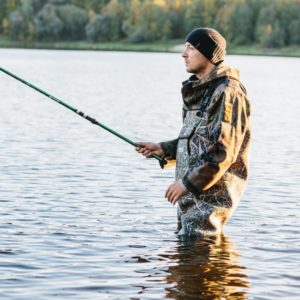
Today, waders are more than just fishing gear specific to trout anglers or salmon anglers, they’re made for all anglers today. Even the cheapest waders that aren’t going to last will allow you to cast your bait a little bit further.
If you’re fishing for you big fish, the waders allow a boatless angler an opportunity to make your way out into shallower water or into deeper water. Basically, it lets you fish water that you wouldn’t usually be able to fish. It’s more than just an opportunity, it’s also a massive advantage for a boatless angler because aside from casting further you will also be able to navigate to water that you couldn’t usually get to without a boat.
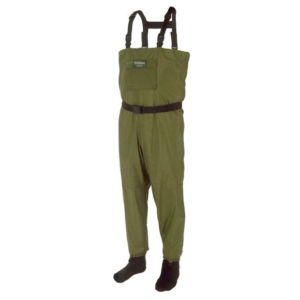
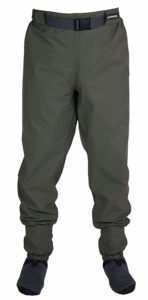
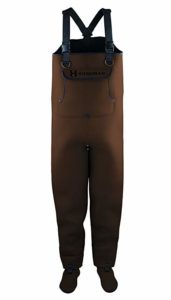
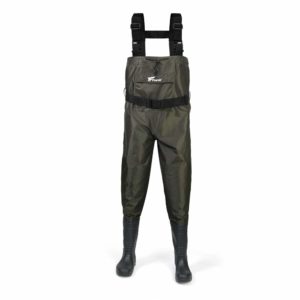
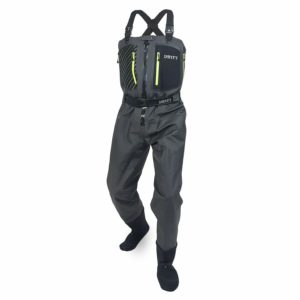
Top 5 Best Fishing Waders in 2019
1HODG.WADELITE 1 SF — Best Bang for the Buck
The best way to start a new type of activity is something generic and basic. If that’s what you want, if you’re new to wading entirely, then the HODS WADELITE may be the right choice for you.
As I said, these waders are as generic as it gets. The use the stockingfoot style, which is the most popular, and they go up to the chest, which is also a feature shared by most modern waders. As for the material, waders are made from Supplex and Horco-Tex fabric. I’m not familiar with them, but they are anything like Gore-Tex, then the end result is waterproof (which is kind of expected), breathable and durable. The product description seems to match this summary, that’s why I think I’m right in my assumption.
All in all, it’s a nice comfortable generic pair of waders. It does have a single peculiar feature: the waders have a built-in belt. Well, that makes isolating the lower part of the body from water so much easier.
Pros
- Breathable
- Durable
- Built-in belt
Cons
- As generic as it gets
2COMPASS 360 High Pant Wader — Best Hip Waders
Most of the time, you don’t need to go any deeper than knee deep. Sometimes, you can’t even get that deep. Sometimes, you have and can get as deep as mid-thigh. So, exactly why would you need waders that go up to your chest?
You don’t, actually. It’s surprisingly rare when you actually have to go hip deep and deeper. Why do people buy chest waders, then? Well, as far as I know, they do it just in case. You never know when chest waders are going to come in handy. Most of the time, they don’t, but who can tell.
What I’m trying to say, these waders are sufficient for almost any goal as long as you don’t need to go in too deep. You probably won’t ever need to buy chest-high waders, unless you’re planning crossing rivers or go in deep enough, so you won’t pay for what you’ll never use.
These nylon hip waders are breathable, more or less light and waterproof. You will have to wait for them to dry when you finally come back to the shore, but that’s the only disadvantage I can think of.
The neoprene socks have gravel guards attached, so you don’t have to worry about that. These waders are as good as any. Only, they don’t go up all the way to your chest.
Pros
- You won’t pay for what you’ll never use
- Breathable
- Gravel guards
Cons
- You will have to wait for them to dry when you finally come back to the shore
- Don’t go up all the way to your chest
3Hodgman Caster Waders — Best Neoprene Waders
If you want your waders cheap, neoprene is the way to go. Just remember, that kind of cheapness comes at a price of its own. Depending on your circumstances, you may be willing to pay it.
As we know, neoprene waders (as well as neoprene everything) are hot. Or warm. That really depends on your point of view and the outside temperature. If it’s freezing out there, you won’t find a pair of waders that’s just as comfortable without any extra lining.
Neoprene is robust and durable, and 100% waterproof. However, it’s not just 100% waterproof, it works both ways. It won’t let any water it, but it also won’t let any vapor out. That’s going to get uncomfortable pretty quick.
If you are still new, I recommend buying something else. Something less cheap or something less durable but also something less hot. Neoprene and moisture-wicking are the two words that aren’t even acquaintances. You’re not going to encounter them together, not without any sort of negation, at least.
As far as neoprene waders go, this pair is the best for their price. If you understand the inherent disadvantages of neoprene and are confident they won’t be an issue for your fishing set up, I advise that you consider buying this product.
Play Video
Pros
- Robust
- Durable
- Best for their price
Cons
- Water vapor can’t escape
- Hot
48 Fans Fishing Waders — Best Bootfoot Waders
Sometimes, the stockingfoot style isn’t just right for a situation. After all, you have to take off your boots, then put the waders on, then put the wading boots on, then make sure the gravel guard is at its place.
These bootfoot waders don’t pack small, but they are a single piece, and you can just put them on, and you’re ready to go. That’s how it works, and that’s what you’re going to get with the 8 fans.
Thanks to the inclusion of nylon, these waders are pretty durable and wear-proof. It would probably be even better if the entire waders were made from nylon, but it’s more expensive than PVC, which is why all it does is reinforces the product.
The boots are cleated and offer good traction on most surfaces, including mossy rocks.
Pros
- Durable and wear-proof
- Reliable traction on most surfaces, including mossy rocks
Cons
- Don’t pack small
5Primo Zip Front Wader — Best Overall Waders
If you want something better than more or less generic waders, then the Promo Zip Front Wader is for you. Its design is pretty standard, but the implementation is far better than any of the other waders on my list.
Let’s talk about the waders themselves first. The inner layer is waterproof and breathable. The upper layer is water repellant and additionally reinforces the waterproofing of the waders.
Usually, getting into chest waders takes at least a minute, and that’s when you have experience. It takes beginners a lot longer than that. But unlike most other waders of this style, the Primo Zip Front is straightforward to put on thanks to the watertight main zipper. You just unzip it, get it, and zip up. It’s that easy. The zippers on the pocket are just as watertight and water resistant.
While that’s cool, I can’t shake off the feeling that the zipper is the weakest point of the waders. If something were to fail, it would probably be the zipper, and when it does fail, it’s probably going to do it spectacularly. I wouldn’t want that to happen to my waders when I’m wearing them.
But maybe I’m overreacting, and they really can hold out a few years.
To give you some more comfort, the waders only have a single vertical seam. But they have more seams that aren’t vertical. Either way, they all are sealed with the NoLeak™ technology.
All in all, these waders are definitely work well done. I could just list its features for five minutes. It’s like that manufacturers have thought of every little detail. A very considerately made product, if nothing else. If it weren’t for the high price, I would recommend it for everyone.
Play Video
Pros
- Water repellant Upper layer. Additionally reinforces the waterproofing of the waders
- Watertight main zipper
- Watertight pocket zippers
- A single vertical seam
Cons
- High price
Buyer’s Guide
If you’re trying to buy some waders and you’re not sure what kind to buy, let’s talk a little bit about the pros and cons of different waders styles. I’m confident I can help you make a better decision.
Basic Styles
First of all, there are two basic styles: a stocking foot style and a barefoot style.The stocking foot is precisely that. The waders come with a stocking on each foot. You put the waders on, but then you need to put separate boots on your feet. The waders come in one piece, and you have to go buy a different pair of wading boots to wear with those stocking style waders.The barefoot style comes with the boot already molded and part of the waders. You don’t get to make any decision regarding the boots, just find the one that fits your foot, and you’ve got a pair of waders.Stockingfoot Style Waders
Stockingfoot style is one of the most popular forms. Let’s talk about the pros and cons a little bit more.Some of the advantages of that style are that waders are very lightweight and travel very well because the stocking foot style folds up small. You could also pick the boots that you want, any style that you like. Typically wading boots are very comfortable, so you get functional, comfortable boots along with the stockingfoot waders. If you have wading boots, you can hike, you can walk around or portage. To put in three words, you’re very mobile, and that’s not something that you get to enjoy with barefoot style waders.However, the reason why stockingfoot style waders are so popular is not the chance to get the boots you like. Stockingfoot waders just are very lightweight, and they pack very well, and they also aren’t costly.Barefoot Style Waders
About the disadvantages first. Barefoot waders are bulkier because of their nature and design. Also, you don’t have any selection whatsoever on the boot that you’re going to wear, but that’s more like a pros and cons situation.On the plus side, you don’t have to make any decision on buying any boots, and you’re not traveling with two separate pieces because you only have one set of waders. That makes you less likely to forget to pack the boots, and if you do end up forgetting the wader, it’s not going quite as frustrating at least. Besides, if the decision on the boots is already made for you, you don’t have to worry about that. So that can be considered an advantage.And finally, barefoot style waders are really great for those who like just to go and be able to throw on some waders real quick, run into the stream, fish for an hour or so, and then run backto work. Getting stockingfoot waders on and off is slower.Hip vs. Chest
Once you’ve decided on the style (barefoot or stockingfoot), the next thing you want to determine is if you want hip waders or chest waders. That’s not the entire spectrum, as there are also waders that come to the waist, but still, hip waders and chest waders are the most popular and easy to find.Hip waders are less expensive. That’s only to be expected, as there is less material and they only go up to the hip. Chest waders have a more impressive price tag, but they go up to the chest.Neither style is better or worse, the choice depends on how deep you’re going to be fishing.If you plan to be fishing deeper water, then the chest waders would be a better and the only option. However, most people don’t wade in a river or a stream much more than slightly above their knees in most situations other than when you’re trying to cross a river or something like that. Most of the time, you’re never going to go above your waist, and hip waders are more than enough. If you only fish in shallower water and just need to walk around knee deep, or maybe 2 or 3 feet deep, chest waders aren’t essential. No need to pay for something that you don’t need, especially since hip waders are also more comfortable.Material
If you’ve made the decision on hip or chest, you need to move on determining the best waders material for your purposes, so let’s consider your waders options.First of all, it’s not outside the realm of possibility to find some really inexpensive waders, such as the nylons or the PVC waders. You can’t buy waders cheaper than them. However, their main disadvantage beats the price advantage.Those waders tend not to last very long. Nylons and PVC waders break down all too fast, especially in extreme conditions. They’re also very easily punctured, and the rate at which they wear out is horrifying.Because of that, I’m going to focus on neoprene and breathable waders. They have their own pros and cons, and either option can be your best choice.Neoprene
Since they first made their appearance, neoprene waders have gone down in price. Today, they are probably three times less expensive than they used to be, not taking inflation into consideration. It’s not surprising, considering that we saw the birth and rapid advancement of breathable waders in recent years. Since they went through a price reduction, neoprene waders had to go down the same route, or else there wouldn’t be any demand for them at all.As far as waterproof materials go, neoprene is one of the first synthetic materials traditionally used for fishing and water sports. Although old, it’s still widespread, mainly due to its low price.The thing with neoprene is it has a very particular advantage that also makes a terrible disadvantage in unsuitable conditions. Neoprene waders keep you very warm, so you can fish in freezing water. Neoprene waders are nicely insulated and come in different thicknesses. You can get yourself a really well-insulated pair of neoprene waders at a very moderate price.For cold water, that’s great, for warm water, less so. In fact, because of that exceptional insulation, neoprene waders tend to be very hot. Even on a cold day, you may end up sweating, but it used to be worse.These days, all neoprene waders are lined on the inside, as well as the outside. The ones that came out a long time ago lacked the lining, and that made them extremely uncomfortable if you wore them in a hot situation. Thankfully, you’re not likely to encounter any of those, except in a pawn shop. The lining on the inside makes the modern waders a little bit more comfortable when the weather is warm, but not as comfortable as breathable waders.Also, neoprene is rather heavy, and it’s bulky. Neoprene waders don’t pack small, even stockingfoot waders. But if you’re only fishing cold water, and the weight and bulk are of no concern to you, neoprene waders would be a good choice.If you’re going to fish a place where the ambient temperatures are not going to exceed 60 degrees Fahrenheit or a very cold place like a lake with ice coming off, neoprene waders can be your best choice.That said, you can make yourself warm and comfortable in breathable waders reasonably quickly, but you don’t have a way to make yourself less hot and sweaty in neoprene waders. I also do not recommend exerting yourself physically if you’re wearing neoprene because that’s going to make you hot and sweaty in seconds. If you tend to wander off your car when fishing, I recommend that you either change your habits, or pack your regular pants and carry them with you when you’re fishing, or simply buy breathable waders instead of neoprenes.Breathable Waders
The other type of material is breathable and lightweight. Nylon would work more or less okay, but it’s not the right choice long-term since it breaks down rapidly. A fabric like Gore-Tex will give you better performance. It can be something different, but I’m going to use Gore-Tex as an example.Wherever we’re talking of waterproof fishing clothing, Gore-Tex is bound to come up. That fabric is breathable and 100% waterproof. Gore-Tex is a lot more expensive than nylon, but nylon is suitable as well.But what does breathable imply?Breathable waders are made of a fabric that allows perspiration to escape through the membranes of the waders but yet won’t allow water to enter into the waders from the outside. Therefore, they’re effectively waterproof.Breathable waders are also usually very lightweight, and they travel well. They’re easier to get on and off because they don’t fit too tight, unlike neoprene waders. They are simply more versatile when it comes to different climates.You could still dress for warmer weather because all you have to do is just layer up on the inside. Put an extra pair of sweatpants underneath or a pair of long johns and just insulate yourself and make your own layers of insulation. Alternatively, you can purchase custom-made inserts explicitly designed for your waders.You could fish wearing them in the summer as is, or you can fish wearing them in the winter after adding some extra layers. Keep that in mind when making an order. You want your breathable waders to run a little bit bigger to accommodate some extra clothing underneath. It’s a tip specific to breathable waders, since neoprene snugs to your body too tightly. You will have to undress before wearing them anyway, and they are so hot that it hardly matters.Features
Watertight Zippers
Modern breathable waders have waterproof zippers. They are quite neat when you need to keep something on you that you don’t want wet. A pocket with a waterproof zipper will remain dry even if you actually submerge the zipper underwater. Water will not go through.I’m not 100% sure how that works, but it does, and I know because I’ve seen them in action and used them.Custom Made Inserts
You’re not going to find them in neoprene waders. And it’s not like neoprene waders need them in the first place, they are too hot as they are.Breathable waders, on the other hand, are more comfortable when it’s hot, but that means you need extra insulation when you’re fishing in cold weather. The inserts for your waders will give you just that.Welded Seams
It’s not like I don’t recommend buying waders that are made with taped seams. However, welded seams lack potential waterproofing flaws by design. They are also more comfortable for the body because you can’t feel them, unlike taped seams.Taped seams are suitable for rain gear, but welded seams offer 100% waterproof attachment, without the risk of leakage as long as they are intact.Safety Tips
If you’re purchasing waders, that implies you’re intending on going into the water (clearly). Considering that, are you bringing a good friend along? If not, you need to reconsider, specifically if you’re going to be fishing a river.Never go out alone if you believe you’re going to find yourself in the water. It’s merely too unsafe, there are too many risks to take, too many things that can go wrong. Even sailing a watercraft alone can be risky, and getting in a quick river, even shallow river, without somebody supporting you is merely asking for trouble.Always use some sort of floatation help, ideally a life vest. You do not need to. However, it’s much better to be safe than sorry. Likewise, always remember your wading belt, since it’s going to keep some air caught in your waders contribute to your buoyancy.When crossing a river or a stream, keep intending slightly upstream when you go. Do not make a step before you’re sure the bottom is not going to give and is not slippery. Take your time to find your ground. If you’re moving too quickly, you can find yourself turning your ankle and falling into the water.You might get some water that you believe is simply too quick to wade usually, and the automatic response would be to turn downstream, given that, if anything, that looks simple. That’s a bad way to do it because you will end up in the water the next second.Even if you fall into the water and it does invade your waders, do not panic. They are going to be heavy when you get out, but in water, they are in fact a bit lighter and, once again, enhance your buoyancy even when filled with water. Leaving the water can be a problem, though, when you’re near the bank since you’re going to need to bring all that water in your waders with you. To put it short, a wading belt seems like an excellent idea.Waders aren’t meant for swimming, and they are going to drag you’re attempting to swim ordinarily. Don’t do it. Instead, spin to your back and keep your face and especially mouth and nose above the water and gradually work your way towards the nearby bank downstream. Ensure you’re drifting with your feet downstream.Don’t attempt to get up if the water is rapid and not quite deep (below the abdomen) since you might end up beat up. Instead, either turn on your stomach and swim towards the bank or wait until the water is a little deeper, so you can stand without getting marks all over your body.Questions and Answers
If you’re not sure what size you need, don’t worry. There are three main measurements that you need to take to ensure the perfect fitting waders. Those are the most substantial girth, inseam, and
shoe size.
The largest girth is usually your chest or belly. The key is not just using your waist or belt size as a measurement, and flattering yourself isn’t really a good idea in this situation. Do not underestimate your largest girth, the waders won’t fit you well if you do.
The inseam is measured from the crotch to the floor, and it doesn’t translate well from your everyday clothes as well. It is always larger than your pants’ inseam. If you’re in between sizes, go up a size just to be safe.
For stocking foot, on the contrary, you should go with your everyday street shoe size. If you’re a half-size, go up.
Once your waders are shipped to you, try them on inside and put the wading belt on. If you can kneel down without much problem or crouch like you’re landing a huge fish, it’s okay to feel a
little pressure on the knees and seat. However, if you feel like you are going to blow out the seam, the waders are too the wrong size, and you should get them replaced. Otherwise, loosening the shoulder straps will often relieve that little discomfort you’re feeling when crouching. You only need the straps tight to test the waders.
